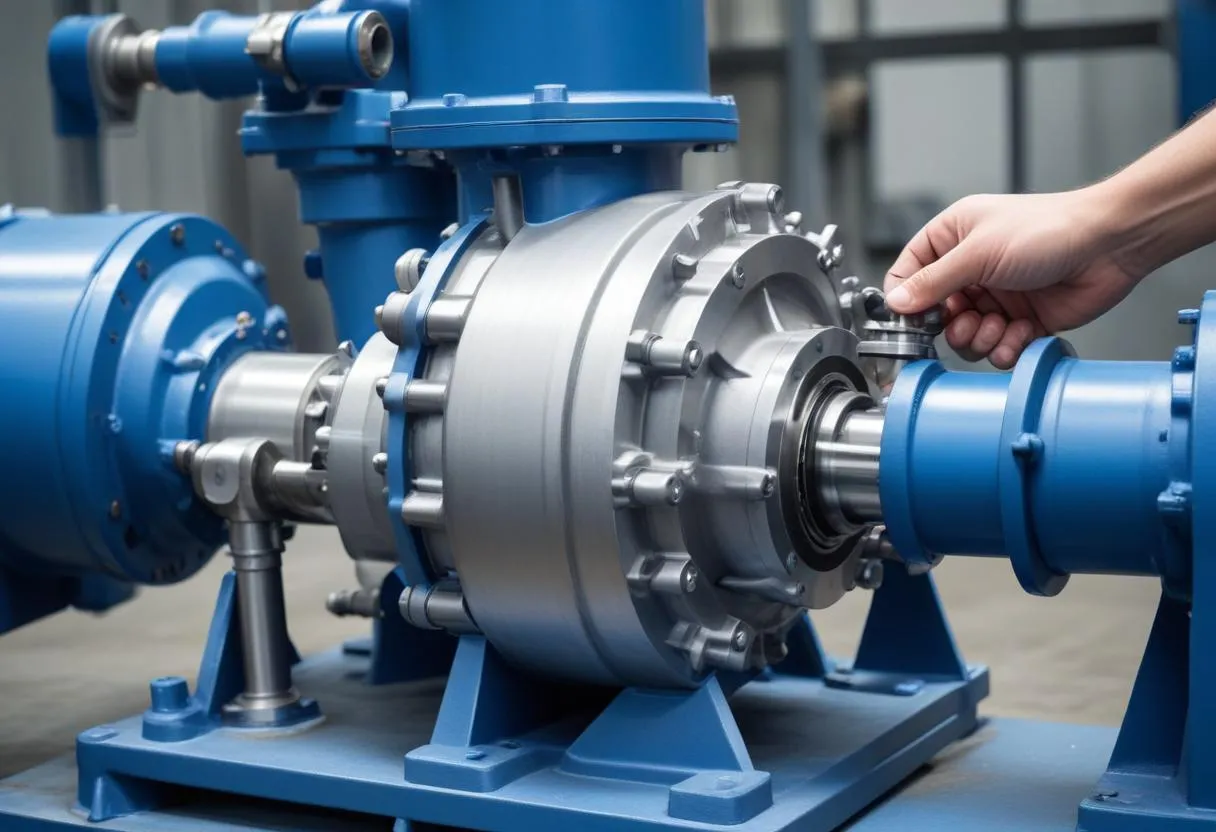 Choosing the correct pump type and size for a specific application is critical in optimizing its performance and extending its lifespan. A mismatch between the pump and its intended use can lead to increased wear and tear, more frequent failures, and inefficient energy use. Here’s what to consider when selecting a pump:
Choosing the correct pump type and size for a specific application is critical in optimizing its performance and extending its lifespan. A mismatch between the pump and its intended use can lead to increased wear and tear, more frequent failures, and inefficient energy use. Here’s what to consider when selecting a pump:
Understanding Flow Requirements: Understanding the volume of fluid that needs to be moved within a specified time frame is essential. You should calculate the flow rate required in gallons per minute (GPM) or liters per minute (LPM). This will help in selecting a pump that can handle the desired capacity without overloading.
Evaluating Head Pressure: The head pressure is the height at which the pump can raise the fluid, and it is typically measured in meters or feet. It’s essential to consider both the static head (elevation difference between the source and discharge points) and the dynamic head (friction losses in the piping system).
Viscosity of Fluid: The fluid’s viscosity can significantly affect pump selection. Higher viscosity fluids require pumps with larger flow passages and possibly different types of mechanisms (such as gear or lobe pumps) compared to low-viscosity fluids, which are typically handled well by centrifugal pumps.
Material Compatibility: The construction material of the pump must be compatible with the fluid it will handle to prevent corrosion or degradation. For example, stainless steel or polypropylene might be preferred for corrosive fluids.
| Type of Pump | Best Use Scenario |
|---|---|
| Centrifugal Pump | Low-viscosity fluids, general water supply |
| Positive Displacement Pump | High-viscosity fluids, accurate flow rates required |
| Diaphragm Pump | Handling corrosive or abrasive fluids |
Power Supply: Ensure that the pump’s power requirements are compatible with your available power supply, whether it’s electric, pneumatic, or hydraulic systems. The efficiency of the power supply can also impact the overall energy consumption of the pump.
Operation Conditions: Consider the environmental and operating conditions in which the pump will function. Factors such as temperature, atmospheric pressure, and humidity can affect pump performance and choice.
- Maintenance Accessibility: Choose a pump that allows easy access for maintenance and repair. This will reduce downtime and maintenance costs over the pump’s lifetime.
- Noise Level: Depending on the installation site, the noise generated by the pump might be a concern. Pumps with lower noise levels might be necessary for residential areas or healthcare facilities.
- Energy Efficiency: Look for pumps with high energy efficiency ratings to reduce operational costs. This is particularly important in applications where the pump will run continuously.
By considering these factors, you can select a pump that not only fits your immediate needs but also operates efficiently and lasts longer. This thoughtful selection process helps in reducing overall lifecycle costs and enhancing system reliability.
Routine maintenance and inspection
Regular Maintenance Schedule: Establishing and adhering to a routine maintenance schedule is crucial for maintaining optimal pump performance and longevity. This schedule should include frequent inspection of the pump and its components. Key maintenance tasks include lubricating bearings, checking seal conditions, inspecting the impeller, and ensuring that the motor is functioning efficiently. Regular checks allow for the early detection of potential issues that could become major problems if left unattended.
Daily and Weekly Inspections: Daily checks should focus on monitoring for unusual noises and vibrations, which can be indicators of misalignment or bearing failure. Weekly inspections might include verifying the integrity of seals and gaskets, ensuring that hoses and connections are secure, and checking for any signs of leakage.
Monthly and Annual Assessments: On a monthly basis, it’s beneficial to inspect the pump’s electrical components and wiring to prevent electrical failures. Once a year, a comprehensive review of the entire system should be conducted. This includes dismantling the pump to inspect internal components such as the impeller, shaft, and bearings. Performing pressure tests to evaluate the pump’s efficiency can also indicate whether internal wear or damage has occurred.
| Inspection Interval | Key Actions |
|---|---|
| Daily | Monitor noises and vibrations, check operational status |
| Weekly | Inspect seals, hoses, and connections for integrity and leaks |
| Monthly | Check electrical components and wiring |
| Annually | Dismantle for internal inspection, conduct pressure tests |
Cleaning Procedures: Keeping the pump and its components clean is essential to prevent buildup that could impair its operation. Particular attention should be paid to any filters or screens that can become clogged with debris. These should be cleaned or replaced regularly to ensure unrestricted flow.
Recording and Documenting Maintenance: Keeping detailed records of inspections, maintenance, and repairs is vital. These records can help troubleshoot future problems and verify that maintenance schedules have been followed. Documentation should include dates, the nature of inspections or repairs, and the names of personnel involved.
By consistently following these prescribed maintenance and inspection routines, you can significantly extend the operational life of your pump, minimize costly downtime, and ensure that the system runs at peak efficiency. Such dedication to routine care also ensures compliance with warranty requirements, potentially saving significant costs in case of failure.
Upgrading and replacing parts
 Upgrading and replacing parts in your pump at the right time is crucial for maintaining optimal performance and preventing premature pump failure. The upgrade and replacement strategy should target components that are most prone to wear and degradation, such as seals, bearings, and impellers.
Upgrading and replacing parts in your pump at the right time is crucial for maintaining optimal performance and preventing premature pump failure. The upgrade and replacement strategy should target components that are most prone to wear and degradation, such as seals, bearings, and impellers.
Identifying Wear and Tear: Regular inspections will highlight components that are beginning to wear out. Parts like the mechanical seal and bearings are particularly vulnerable to wear due to their constant exposure to movement and fluid dynamics. When you notice signs of wear, such as reduced efficiency, leakage, or abnormal noise, it’s time to consider an upgrade or replacement.
Choosing Quality Replacement Parts: It’s important to select high-quality replacements to ensure long-term reliability and performance. Opting for original equipment manufacturer (OEM) parts can often provide assurance of compatibility and quality. However, reputable aftermarket parts can also offer comparable quality at a potentially lower cost.
| Part | Recommended Replacement Interval | Signs of Wear |
|---|---|---|
| Seals | 2-3 years | Leakage, visible wear or damage |
| Bearings | 3-5 years | Noise, vibrations, heat generation |
| Impeller | 5 years | Reduced flow rate, efficiency drop |
Upgrade Opportunities: Upgrading parts provides an opportunity to enhance the efficiency and functionality of your pump. For instance, if improvements have been made in impeller technology or if new seal materials have become available, upgrading these components can reduce energy consumption and increase the pump’s operational life.
- Energy-Efficient Motors: Consider replacing older motors with energy-efficient ones that consume less power and reduce operational costs.
- Advanced Seals: Look for advanced sealing technologies that offer improved resistance to wear and better handling of higher pressures and temperatures.
- Corrosion-Resistant Materials: Upgrading to corrosion-resistant materials can significantly extend the lifespan of pump components exposed to harsh or abrasive fluids.
Implementation: When performing upgrades or part replacements, ensure that the pump is decommissioned safely according to its operational manual. It’s also advisable to involve qualified technicians to perform the work, which helps guarantee that the installation meets industrial standards and maintains warranty conditions.
By thoughtfully planning the upgrade and replacement of key pump parts, you can significantly improve the performance, efficiency, and reliability of your pumping system. This proactive approach not only extends the lifespan of the pump but also prevents the likelihood of unexpected breakdowns and associated downtime costs.